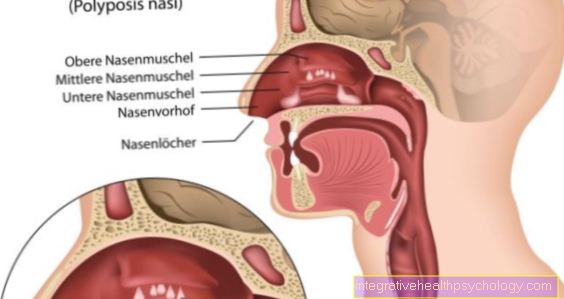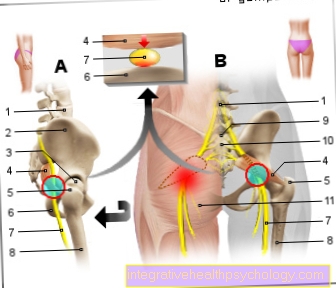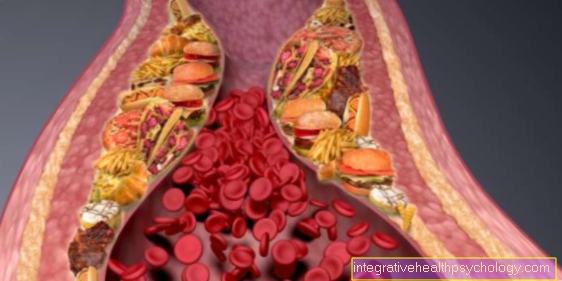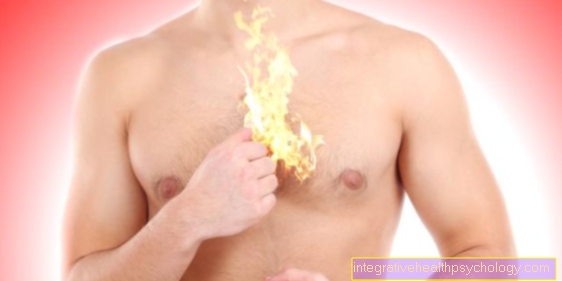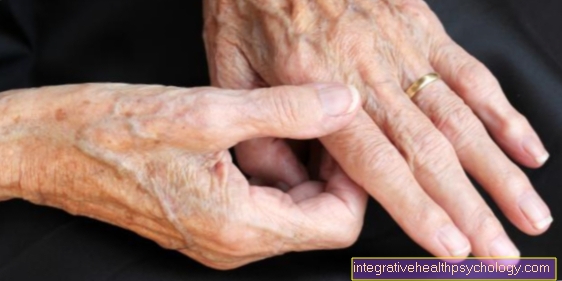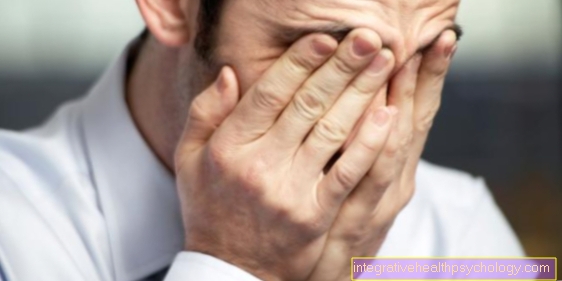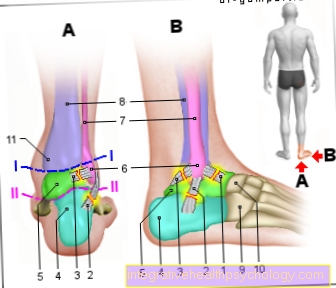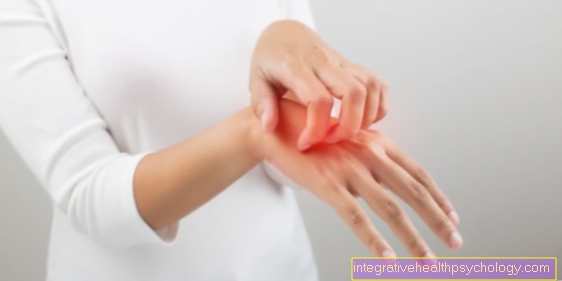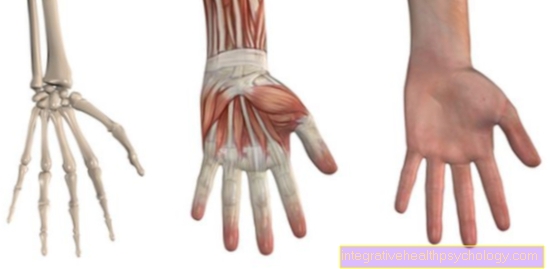The sense of balance
synonym
Vestibular perception
General
The sense of balance is used for orientation and the determination of posture in space. Various sense organs are necessary for orientation in space. These include the organ of equilibrium (Vestibular organ), the eyes and their reflexes, as well as the interconnection of all stimuli in the cerebellum. In addition, the sense of balance contains the feeling for
- above and below,
- Angles and slopes, as well
- Linear and rotational accelerations of the head.
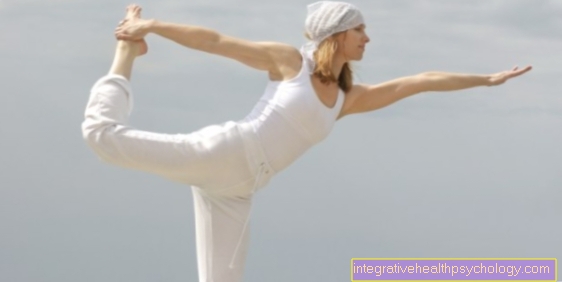
The vestibular organ
The vestibular organ is composed of:
- the inner ear with the sense of balance and
- the cerebellum and its balance functions.
The inner ear can be roughly divided into three components:
- The cochlea (Cochlea) serves the hearing sensation,
- Sacculus and utriculus are used to perceive straight-line accelerations and spatial position and the
- Semicircular canals (Semicircular duct) are used to sense rotational accelerations and rotary movements.
Sacculus and utriculus are two interconnected cavities, which are filled with endolymph and each contain a macular organ. The two macular organs of the sacculus and utriculus are almost perpendicular to each other. The macula utriculi is horizontal, the macula sacculi vertical. The macular organs contain supporting and sensory cells which are covered by a gelatinous dome. This contains statolites made of calcium carbonate.
The action of gravity creates a shear force between the movements during movements
- Statolith membrane and the
- Sensory cells.
This triggers stimuli that are transmitted through the nerve to the brain to get redirected. Just like the saccule and vestibular perception, the three semicircular canals also contain sensory and supporting cells. The semicircular canals are circular and connected to each other and to the rest of the inner ear. The three arches are perpendicular to each other and each contain an ampoule. This ampoule stands transversely in the lumen of the semicircular canal and contains the sensory and supporting cells. These are also covered with a gelatinous dome and lead to the transmission of sensory information through shear forces. Depending on the direction of movement of the individual cells and their speed, the brain can differentiate between the individual movements.
Of this Vestibular organ the leads from the inner ear VIII. Brainerv, of the Vestibulocochlear nerve, to the corresponding nerve nuclei in the Brain stemm (Vestibular nuclei). Since the information from the inner ear alone is not sufficient to be able to maintain the balance, information from the
- Eye muscles and about the
- Position of the head in relation to the trunk necessary.
In order to be able to process this information together, the vestibular nuclei are connected to the cerebellum, the Spinal cord and the eyes connected. The interconnection of the balance organ with the eye muscle nuclei is called Vestibular ocular reflex designated.
To understand its function, the cerebellum must be divided into three parts:
- Vestibulocerebellum,
- Spinocerebellum and
- Pontocerebellum.
The vestibulocerebellum in particular receives a lot of information from the inner ear and also sends converted information back to it. In addition, this part also sends information to the eye muscle nuclei and is therefore involved in the fine-tuning of almost all eye movements. In addition to eye movements, the vestibulocerebellum can also send and receive information to the extrapyramidal tracts of the spinal cord. This gives the cerebellum an influence on the supporting motor skills of the trunk.
The Spinocerebellum receives a lot of information from the
- Spinal cord and thus about the
- Position of the legs and arms, as well as the
- Muscle tone of the trunk.
This can do that Cerebellum the information from the spinal cord to the Vestibular organ and the Eye muscles send and vice versa. This enables constant fine-tuning and control between the individual components of the sense of balance. If one of these important organs fails, for example Dizzy spells to be triggered.
Examination of the organ of equilibrium
There are various tests to control the Balance organ.
- in the Romberg experiment the patient stands in the room with his eyes closed and arms stretched out horizontally. The examiner assesses the safe was standing and a Tendency to fall of the patient.
- in the Unterberger step attempt the patient must also go on the spot. Again, the Tendency to fall judged backwards or sideways.
For the experimental testing of the Vestibular organ will that ear each rinsed with warm and cold water. The patient lies on his back with his head slightly raised. To avoid orientation in the room, the eyes should be closed. Rinsing with warm or cold water causes the Endolymph in the vestibular organ.
A feeling of dizziness and a lateral twitching of the eyes (Nystagmus) are triggered. If the vestibular organ is not restricted in its function, the Hot water flush the eye towards the irritated ear, in which Cold water rinse in the opposite direction. Deviations from these physiological movements suggest various disorders in the Inner ear conclude.
How can you train your sense of balance?
Compared to our other senses, the sense of balance can be trained very well. Children give the best example of this in the course of their development. While they keep falling on their first attempts at walking, at some point they manage to develop a safe gait. The reason for this is constant practice and trial and error.
This ability to improve our sense of balance lasts our whole life. The sense of balance is made up of three components. These include the organ of equilibrium in the inner ear, the visual influences of the eyes and the proprioceptors of our joints. To train balance, you have to challenge these three systems against each other.
Most exercises can be done standing up. For example, you can try to stand on one leg without falling over. The body has to adapt to the new circumstances by shifting weight on one leg. This is done by making minimal changes in the ankle or by compensating movements with the arms. The exercises can be varied and changed depending on your own ability. You can bend your upper body forward, bend your knees or circle your arms. You can also close your eyes. This means that the feedback from our eyes as to where exactly we are in the room is lost. This makes it difficult for the body to keep its balance. Another example would be balancing on walls, curbs, or ropes.
Basically the motto "Practice makes perfect" applies. The more often you move your body into new positions and thereby provoke your sense of balance, the better and faster you can cope with these new situations through newly learned movement sequences.
Why does a disturbance of the sense of balance lead to dizziness?
Dizziness is caused by contradicting information sent to the brain from the various sensory organs. The sense organs include the eyes, the two organs of equilibrium in the inner ear and the position sensors (Proprioceptors) in the joints and muscles. All this information converges in the brain stem and cerebellum and unconsciously informs us of our position in space. If one of these systems fails or provides incorrect information, the brain cannot interpret this and dizziness or vomiting is triggered.
This can best be illustrated by the famous seasickness. While the balance organ in the inner ear detects the strong fluctuations of the ship as strong movements of the body in all directions of space, the eyes convey an immobile, static environment, for example inside the ship. This creates contradicting information that the brain cannot classify. This creates dizziness in those affected.
You may also be interested in this article: How is vertigo treated?
Which diseases disturb the sense of balance?
Balance disorders can either be triggered directly by diseases of the balance organ in the inner ear or as a result of another organ disease or injury.
The diseases that directly influence the sense of balance include an inner ear inflammation, Menière's disease, benign paroxysmal positional vertigo, an inflammation of the equilibrium nerve (Vestibular neuritis), a tumor between the cerebellum and the ear canal (e.g. Acoustic neuroma) or one Semicircular canal dehiscence (Disease of the bony semicircular canal).
The disorders and diseases that influence the sense of balance in the further course include electrolyte disorders, hypoglycaemia, lack of fluids, head injuries such as a traumatic brain injury or concussion, sunstroke and heat stroke, poisons and luxury foods (e.g. alcohol), meningitis and brain inflammation (Encephalitis) or circulatory disorders, for example after a stroke.
These articles might also interest you:
- What is Meniere's disease?
- What is paroxysmal positional vertigo?
- What is an acoustic neuroma?




